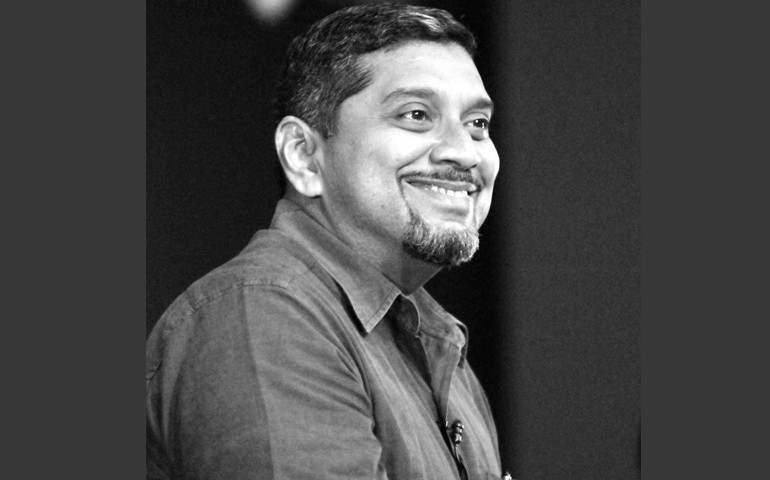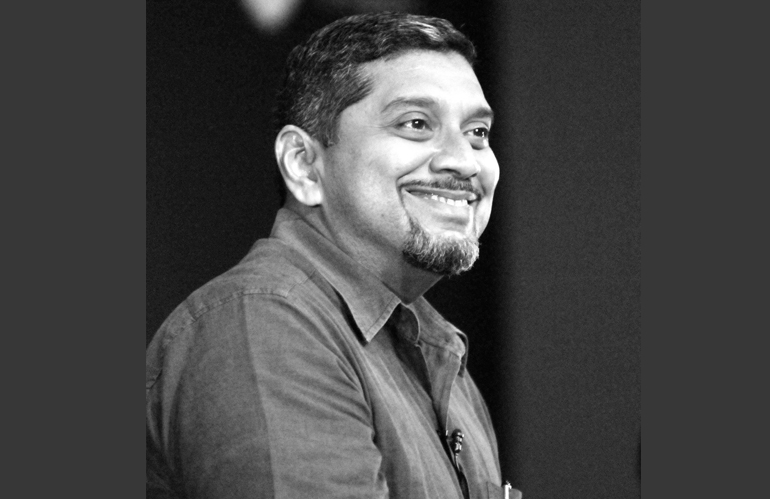[w8_row margin_bottom=”30px”]
[w8_column type=”col-md-6″]« Rajesh Rai, Indians in Singapore, 1819-1945: Diaspora in the Colonial Port City, New Delhi: Oxford University Press, 2014[/w8_column]
[w8_column type=”col-md-6″]Intertwined Destinies- Mr Lee Kuan Yew and Singapore »[/w8_column]
[/w8_row]
It is not about SINDA – it is about US! – January 16th, 2015
Mr VIswa Sadasivan, Vice President, SINDA (Singapore Indian Development Association)
“Viswa Sadasivan is Vice President of SINDA and has served on its Executive Committee for 20 years. A highly respected figure in the Singapore media and communications sphere, Viswa is CEO of Strategic Moves Pte Ltd, a corporate strategy & crisis communications training and consultancy firm which has an impressive list of more than 100 public and private sector organizations, including some Fortune 500 companies. Viswa is also an sought after political commentator and public policy analyst. He served on several national committees and boards, including the Economic Review Committee, the Remaking Singapore Committee, Government Parliamentary Committee on Defence & Foreign Affairs, Media Development Authority, SPRING Singapore, NUS Alumni Advisory Board and the Responsible Gambling Forum. Holding the rank of Colonel, Viswa serves as Deputy Director of Joint Operations in the SAF in his National Service capacity. Viswa was a Nominated Member of Parliament for one term. He holds a Master of Public Administration degree from Harvard University.”
Mr Viswa Saasivan talks about ‘It is not about SINDA – it is about US’
Indians have this traditional North Indian-South Indian divide apart from the multitude of languages, and the different religious orientations. This is less pronounced in the Singapore context mainly because English is the accepted lingua franca, but it is certainly not absent. The truth is, unlike the ethnic Chinese (who have a common language in Mandarin), and the Malays (who have a common language and religion), for the Indian community, we are hard-pressed to find common ground that helps to unify us except that our forefathers hailed from India. This diversity can be both a liability and a many splendoured thing.
SINDA was formed to uplift the entire Indian community for self help. To tell the truth, when SINDA was formed, I was not in favour of it. It went against my core belief we are a Singaporean Singapore and should not be channeling assistance and support according to ethnic affiliations. This is a belief that I still hold close to my heart.
In 1994, Mr J.Y.Pillai– who was then President of Sinda – asked me out to lunch. It was to be a turning point for me. I shared my reasons for not wanting to be involved in Sinda.
In his inimitably urbane manner, he asked me, ‘if you see a poor child with a lot of potential, will you help him?’ I said, ‘Certainly, I will’. To this he responded, “then why is it that you wouldn’t help an Indian child?” He presented a potently persuasive “yesable” proposition: “we should see our involvement in Sinda as not so much helping Indian kids, but helping deserving young Singaporeans who happen to be Indian….”
That conversation paved the way for my 20 year commitment to Sinda which started in 1994 – as a member of the Executive Committee. Regardless of the many challenges and frustrations, it has been, without doubt, one of the most meaningful and fulfilling journeys in my life.
One thing that has become evident over the years is that there is a segment of the Indian community where citizens are more comfortable and confident to share their plight with someone of the same ethnicity and especially who speaks the same vernacular. No matter how comprehensive and effective our products and services are, they will come to naught if you can’t reach out to your constituents, or if they can’t relate to you, or worse, if they don’t trust you. This is something that many of us who are essentially English speaking fail to see or even fathom.
The other hard truth that has kept us awake in Sinda is that those who need help the most and urgently often aren’t aware of it and tend to be extremely hard to reach emotionally and even physically. Sometimes it is reticence and even irresponsibility, and sometimes it is because they are in a state of denial. Oftentimes, it is because they are awkward about asking for help or because their lives are a daily struggle to meet basic physical and emotional needs.
While education continues to be our core focus – as a lever for social leveling – Sinda, has over the years, come to realize that this is not enough. No matter how much we teach the students through our STEP and TEACH programmes, it will be hard for the kids to make real progress and reach their potential if their home environment is dysfunctional. The causes of these emotionally disruptive conditions at home can come in the form of financial struggle, family violence, unstable family relationships including consequences of divorce, and the various forms of substance abuse (such as drug and alcohol consumption). In some of these aspects, the Indian community can be disproportionately represented.
Sinda’s primary concern is how these conditions can adversely affect the child. This is where, apart from tuition classes, we have carefully planned and rolled out many direct and indirect social support and befriender-type programmes for affected families. For example we have project Victory where the kids have “big brothers/sisters” engaging them in very small groups to boost their self esteem. There are intensive motivational programmes for the kids and for the parents. There are Reading programmes targeting younger children whose parents don’t have the time (because they are working two shifts) or don’t have the literacy skills. There is also project Athena – a v successful initiative – to help single parents (mothers) to acquire specialized skills (such as sewing) which will not only help provide them a sustainable means of income, but also make them feel reassured that they are not alone in their struggles.
Essentially we want to intervene early in a child’s life – from pre-school and primary school levels – because this increases the chances of shifting the trajectory of the child’s development in a predictive manner. Taking a more holistic approach – tuition, motivation for the child and parents, mentorship, parent empowerment, and direct financial or physical support where relevant – has been time and resource intensive, but highly effective in helping to lift the quality and standard of life of the less privileged in the Indian community.
As it is the 100 strong management and staff of Sinda, have been working day and night, six to seven days a week to not just meet the output targets but the more challenging outcome targets which are less tangible but critical. As the rest of society progresses at fast pace, the risk of a larger number of people being and feeling left behind will increase at an increasing rate. Time is not on our side if we are serious about tackling the stubborn issues of our community.
One thing is very clear to me – there is no way Sinda can achieve what is needed to be achieved by ourselves. We simply don’t have the financial or human resources to do this. It is estimated that the number of people at risk of being left behind ranges from 20,000 to 30,000!
It has to be truly a community effort that Sinda would provide leadership for.
To achieve this, in my view, three things need to happen. First, individual members of the community must step forward. Second, organisations within the community need to see the difference they can make and proactively strive to contribute in their own ways. Thirdly, individuals must be motivated to group informally to service specific needs of the community. Sinda must and will continue to step up efforts to make this happen and, where necessary, coordinate initiatives.
So far, Sinda’s efforts to work with Tamil teachers have proved to be most effective in helping to identify ethnic Indian students who are at risk. These teachers have been forthcoming in providing us with timely and valuable information and insights, and also in helping to persuade the families to seek help from Sinda.
Similarly, Sinda has been working closely with NarpaniPeravai and the various Indian Activities Executive Committees (IAECs) to reach out to the families that need help in their respective constituencies. Similar arrangements with religious organisations as well as with the key temples, mosques and churches are in place, not only to reach out to those who need help but also to publicise and promote the various Sinda programmes.
An important segment we must connect with and reach out to is the youth. The fact is youth listen to youth. Sinda must and will continue to find innovative ways to galvanise the immense energy and power in this segment. The approach clearly has to be different. For one thing, social media needs to be a key lever. The Sinda Youth Club (SYC) – a semi-autonomous body – was formed a few years ago for precisely this reason. Benefiting from able stewardship, the SYC has been immensely successful in bringing together a significant number of highly energized youth from various educational backgrounds and empowering them to make a difference in their own way. Apart from being funded by Sinda, the SYC today runs on its own steam – driven by a sense of ownership in the participating youth. This is the model we hope to replicate in our engagement of the other organisations in the community.
One of the key outcomes we need to strive to achieve would be for parents – regardless of what the family background may be – to place greater importance in their children’s education. This would mean sacrificing other needs.
Here’s a telling example of what happens when our children’s education is not a priority. Several years ago I was involved in initiating and managing a co-operative organization called the “IT Services Co-operative”.Sinda was a key institutional member of this organization. The aim was to put a personal computer in the homes of low income families. As a launch initiative we decided to give away brand new PCs to 100 needy families with school going children. The event was on a Saturday afternoon, and all 100 recipients had confirmed their attendance the day before. However, during the event only 30 recipients turned up to collect their vouchers. When our staff officers called up those who failed to show up despite confirming, we were presented with a shocking and painful reality. A key reason given by most of them was that they didn’t wish to miss watching the “kamalahaasan” Tamil movie that was showing on TV!
This incident has left an indelible mark on me. It is a constant reminder of the difficult and insidious nature of problem we have to tackle. Sinda’s aim cannot be simply to improve the academic performance of the students – which is in itself a herculean task. Our mission has to be to help shift the thinking and attitude of those who make up our community, especially the parents. Only then, can and will the change be meaningful and truly sustainable through the generations. This would need all of us to become more aware of the challenges our community faces, and assume collective ownership in tackling it.
It is not about SINDA – it is about us.
What does this mean, in real terms. Firstly, on Sinda’s part we need to double or treble our efforts to reach out and empower sub-ethnic, civic or religious organisations in the Indian community to step into the arena in an organized and sustained manner. We need to let a thousand flowers bloom in their own unique, spontaneous ways and celebrate this.
On the part of the community, we must be prepared to put aside or deal with issues that prevent us from working together in the best interest of the less privileged. This means having the ability and the will to rise above the factors that divide us – language, religion, class, caste or whether we are home grown or newer arrivals. We need to focus and stay focused on the common goal of strengthening and raising the standing of our community by empowering and celebrating those who are doing well. More importantly, we must be prepared to do some heavy lifting to help those who are at risk of being left behind.
As Sinda and as a community, we need to develop not just a collective reflex but a collective conscience; a collective will.
So, do we have what it takes?








No Comment